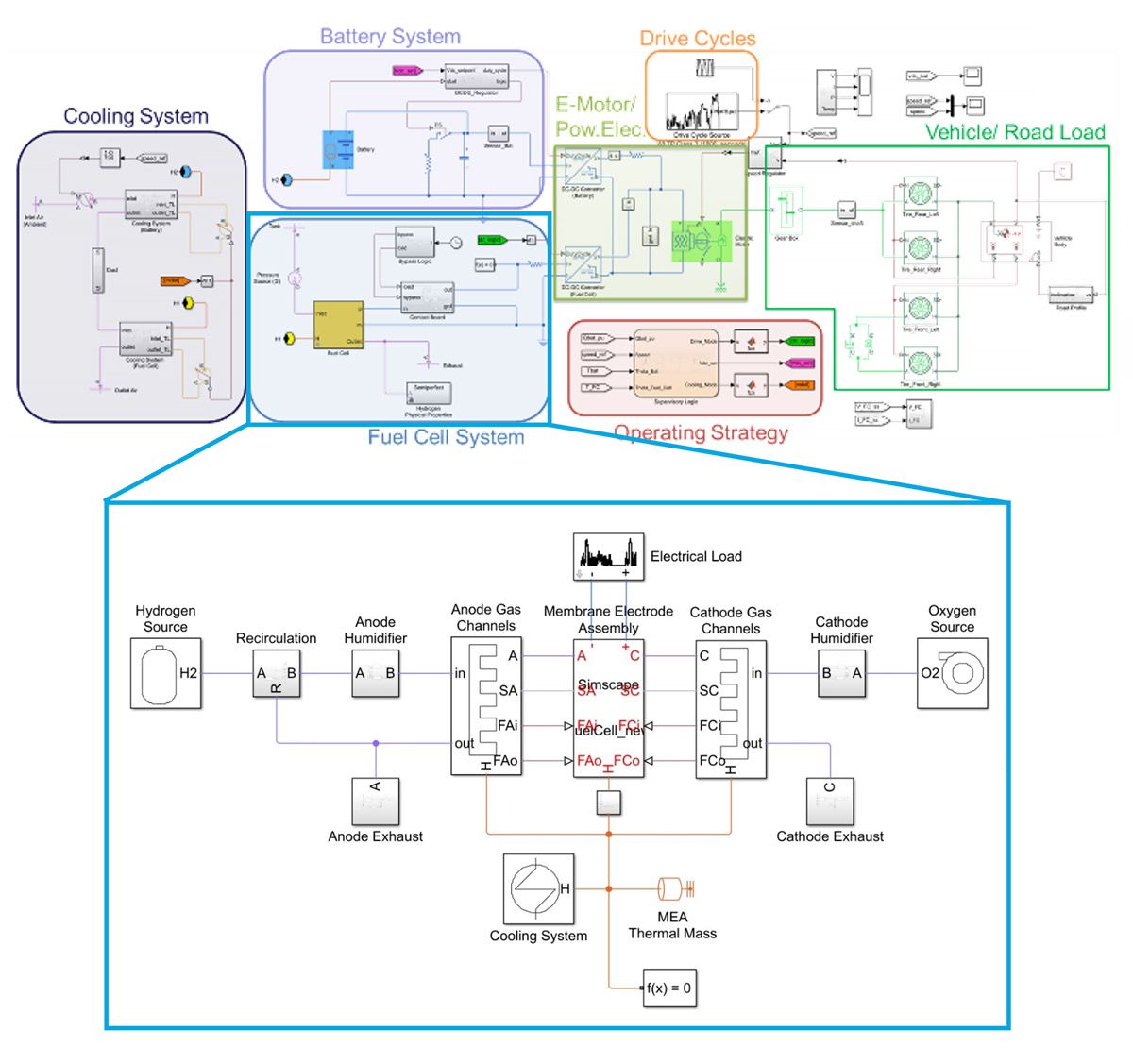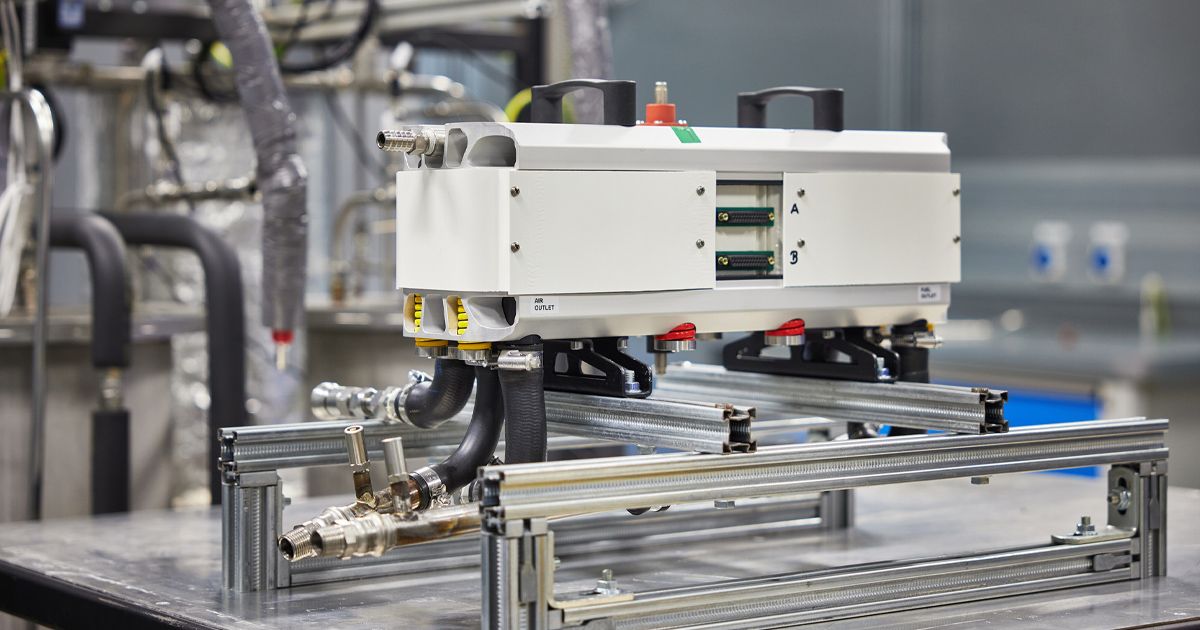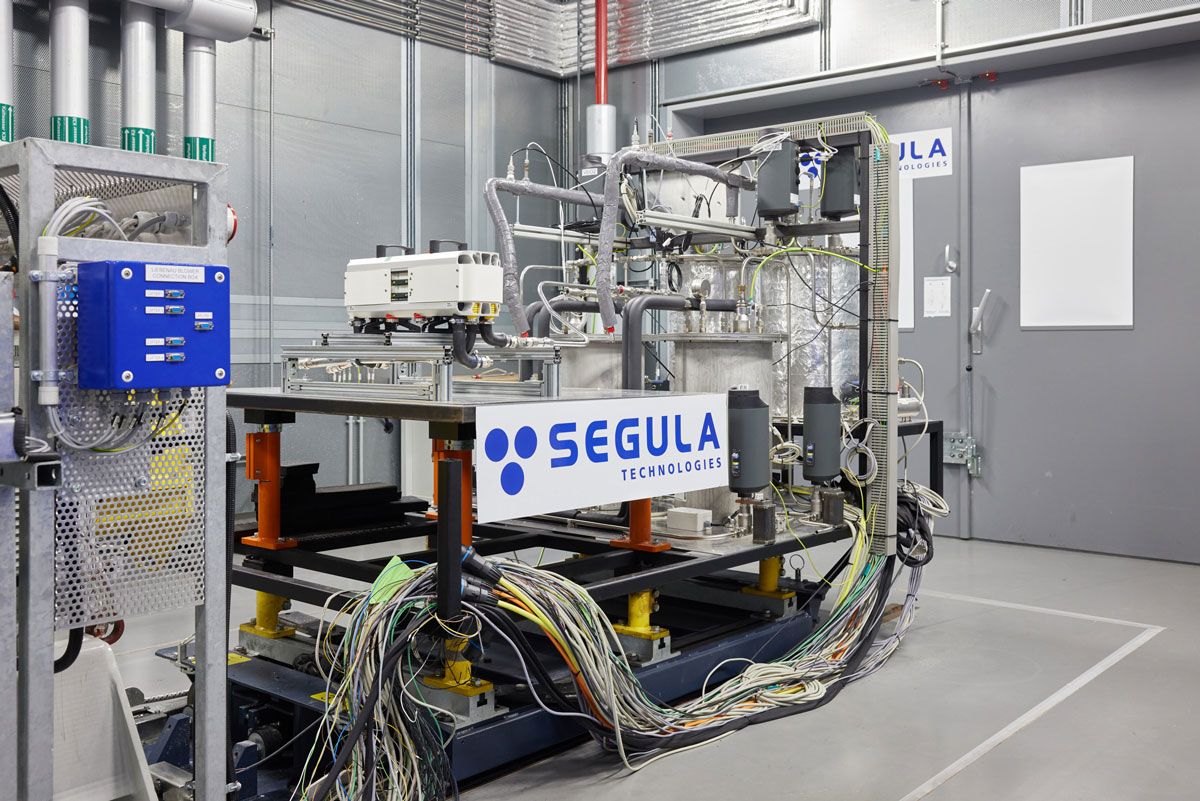This Clean Power Source Is Helping Fuel the Future of Transportation
Overcoming Challenges of Hydrogen Fuel Cell Development with Model-Based Design
A vehicle fuel source that reliably creates energy and releases only water vapor as exhaust sounds too good to be true, but that’s exactly what hydrogen fuel cells are. Yet, battery-powered electric vehicles are still far more common on the road due to more readily available charging stations. The infrastructure for replenishing hydrogen fuel cells is not in place.
Today, hydrogen fuel cells are making a resurgence. The International Energy Agency is encouraging investment in hydrogen research and development, and companies are testing hydrogen fuel cells in small planes, heavy-duty trucks, trains, marine vessels, and other locations where hydrogen replenishment can be centralized for many vehicles.
Accurately modeling fuel cells and building durable ones pose challenges and are an obstacle to broader adoption. SEGULA Technologies is using MATLAB® and Simulink® to overcome these challenges. They’re creating models incorporating artificial intelligence (AI) to reduce production time and costs and provide the transportation sector with a clean alternative to fossil fuels.
Clean Power Source
Hydrogen-powered polymer electrolyte membrane (PEM) fuel cells, also known as proton exchange membrane fuel cells, are lightweight, can refuel quickly, and meet higher energy density than batteries. They can also operate continuously, making them a more practical option than batteries for heavy-duty cargo and shipping.
Using system-level simulation to validate the design before testing with hardware prototypes saves time and money.
When hydrogen fuel is created with renewable resources, hydrogen-powered fuel cells can help decarbonize sectors that are difficult to electrify with batteries. “It’s a very clean power source,” says Dirk Rensink, the technical lead for fuel cell simulation at SEGULA Technologies.
But the energy demands of obtaining hydrogen, the infrastructure needed for hydrogen storage and transport, and limited refueling stations have hindered the proliferation of hydrogen fuel cells. Even as those obstacles are addressed, designing and developing these power sources can be costly. Using system-level simulation to validate the design before testing with hardware prototypes, however, saves time and money.
Modeling Fuel Cells
SEGULA Technologies engineering campus in Rüsselsheim, Germany, focuses on PEM fuel cell development, and creating the necessary models is the SEGULA team’s first step. SEGULA engineers turned to Model-Based Design with Simulink and Simscape™. As a starting point, they used a fuel cell plant model from Simscape. “Starting with a Simscape model shaves four to six weeks off of the initial development time,” says Rensink.
The SEGULA team progressed the Simscape models to create a more sophisticated and flexible model that could lend itself to any fuel cell application—whether for automotive, rail, aerospace, or marine applications. The model would help determine if the optimal sizing for its components had been chosen, whether a given PEM fuel cell design could generate the required power, and whether the controls function properly.
The SEGULA team also needed to factor in behavior such as nitrogen accumulation, water vapor transport, and water droplet flight patterns, all of which impact fuel cell function. “We are investing a lot of time and effort into understanding water transport phenomena,” says Rensink. “This is one of the unique features of our model.”
The model comprises the many components needed to generate electricity, including a compressor, humidifiers, heat exchangers, and water vapor exchangers. “Ensuring the components work well together is crucial for optimizing the energy efficiency and longevity of the fuel cell,” says Rensink.
The team develops the models using three-dimensional modeling tools to simulate the physics inside the cell, particularly the flow of water droplets and vapor and heat transfer. The engineers then plug this data into a Simscape model to simulate how the components of the fuel cell interact with the Simscape model, enabling faster and more flexible system-level simulations.
“Starting with a Simscape model shaves four to six weeks off of the initial development time.”
In addition to confirming the design works, the simulations help limit the fuel cell’s energy consumption, ensuring that it doesn’t consume too much of the generated energy to operate its own compressors or pumps.
With limited real-world data to inform and refine the approach, the SEGULA team turned to an expert system. “It’s not quite a ChatGPT for parameters,” says Rensink, “but it’s an intelligent system that can look back into previous simulations we’ve done and extract a similar kind of parameter. Then, based on that previous experience, it makes a suggestion for any missing parameters in the new model.” With this approach, the team doesn’t need to start from scratch with every new fuel cell system they design, guessing the best values to plug into the models.
“The models evolve as we feed them past data, and we’ve made a big step with the expert system,” says Stephan Schnorpfeil, the fuel cell team leader at SEGULA Technologies.
The models give the SEGULA team the opportunity to test their design before even putting together a prototype. They validate and test the fuel cell controllers via hardware-in-the-loop (HIL) testing, simulating how the fuel cell might fare during a typical week in action or even a 30,000-hour lifetime. Using Simulink Real-Time™, they test the function of the controllers, with the compressor and humidifier being the main players, in the fuel cell.
“Normally you build the system prototype on a testbench and then calibrate your software, but the model makes the environment for testing the fuel cell software that’s used in the field,” says Schnorpfeil. “With this upfront testing, you can calibrate the correct values, and we have been relatively close to reality.”
“When we put the system on the testbench with the calibrated model that we simulated upfront, we have much faster development time than we would have if we had to do everything on the testbench."
The model is already saving time and money, leading to a smoother process for SEGULA’s customers. For instance, SEGULA engineers have been able to tweak fuel cell systems before delving into building prototypes, saving them from costly mistakes. “When we put the system on the testbench with the calibrated model that we simulated upfront, we have much faster development time than we would have if we had to do everything on the testbench,” says Schnorpfeil. Rensink says that the AI-assisted parameter database further helps reduce time to market for customers.
SEGULA’s modeling work also offers customers specialized solutions only sophisticated simulations can address. This flexibility allows them to simulate and develop PEM fuel cells for a variety of applications and power demands, such as adapting a customer’s marine fuel cell system for an automotive application. Other customers have used SEGULA’s resources to quickly extract the ideal parameters for component sizing to optimize their PEM fuel cell system.
The Next Generation
Some of the fuel cells developed with SEGULA’s modeling approach are already at work. The SEGULA team is working to refine their design further, feeding the growing knowledge base of real-world data back into the model.
Education is another major focus. When developing and refining the model, the SEGULA team has worked with bachelor’s and master’s level students from Bingen Technical University of Applied Science and RheinMain University of Applied Science to mathematically model how each component fits and functions within the fuel cell system.
“Students can see that what they’re doing in their university studies does have an impact on the industry. At SEGULA, our fuel cell mission also includes educating and getting the next generation of engineers into the field of renewable energy and fuel cells.”
“Students can see that what they’re doing in their university studies does have an impact on the industry,” says Rensink. The team gives the students practical experience they can use when they leave school. “At SEGULA, our fuel cell mission also includes educating and getting the next generation of engineers into the field of renewable energy and fuel cells.”
Read Other Stories
GREEN TECHNOLOGY/CONTROL SYSTEMS
Hydrogen Fuel Cells Reduce CO2 Emissions
Electrifying Commercial Vehicles with Hydrogen Fuel Cells
GREEN TECHNOLOGY
From Virtual Vehicle to All-Electric Off-Road UTV in Less Than a Year
Going Green with an All-Electric Utility Task Vehicle
GREEN TECHNOLOGY/CONTROL SYSTEMS
Containing the Power of the Sun
The Path to Carbon Independence Through Nuclear Fusion



